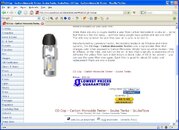
Most of the ones outside of the US are not following existing testing rules now, but - explain your idea...?
We shouldn't have to test our tanks. The Ops should.

Don I applaud your efforts to increase awareness on this important topic and the fact that the majority of fill stations do not test their compressed breathing air quality despite PADI's recommendation that it be done on a quarterly basis. This is not only a problem offshore, but also right here at home where it is difficult to find an air analysis done at any dive shop these days, moreso as the economy contracts and the owner/operators try to cut costs.
The problem with quarterly air tests is they only represent a point in time and the air quality could go downhill the day after the test was done if a idling vehicle backed up to the air intake for example. The auto drains on the compressor could dysfunction in the interval between tests such that the filters become moisture saturated and no longer can protect the compressed air stream from contaminants. The end user or diver would have no way of knowing the air was problematic in these situations.
While quarterly testing is better than nothing, particularly if the operator is testing the system just before the filters are changed out, real-time monitoring is the way to go in the 21st century. The cost of real-time carbon monoxide monitoring has come way down and a commercial fill station can install this Analox CO Free monitor for only $US600 which will alert the compressor operator to elevated CO levels. A sensor replacement is about $150 every 2 years. It can also be wired in to the compressor's control panel such that if an elevated level of CO is detected the compressor will shut down.
Sport Diving - Carbon Monoxide Alarm
http://www.analox.net/site/content_datasheets/CO_Clear_datasheet.pdf
The CO-Cop is an excellent economical device for the traveling diver, but it is not comparable to a real-time electrochemical CO detector. For one it relies on the interpretation of a colour band which not all users may discern, particularly at the lower CO concentrations. The exact number of uses one can get out of a indicator cartridge can vary depending on exposure to humidity, other contaminants, etc. so it could be possible to have the device read negative when there is actually CO in the breathing air (false negative test) if the indicator cartridge is not fresh. That being said I think for the diver who is looking for some level of protection above the no level we currently have out there it is a very useful device, but one must remain knowledgeable regarding the device's limitations.
The other big advantage of real-time monitoring of CO during the fill process is that each and every tank is checked. It is not uncommon during these CO contamination incidents to find several tanks in a string contaminated but with widely varying levels from non-lethal to lethal. Unless all the tanks are checked with a hand held device it is possible to miss a contaminated tank. Your tank might be fine or only have a few ppm of CO, but your buddy's tank may have 100 ppm.
Real-time testing for CO contamination at all fill stations is probably what we should be pushing for in the 21st century. It would be nice if PADI and the other training agencies stepped up to the plate and also encouraged operators to install this affordable technology.



 Most of the ones outside of the US are not following existing testing rules now, but - explain your idea...?
Most of the ones outside of the US are not following existing testing rules now, but - explain your idea...?
